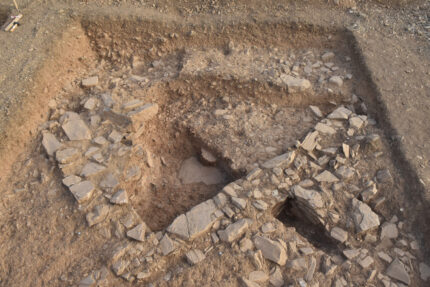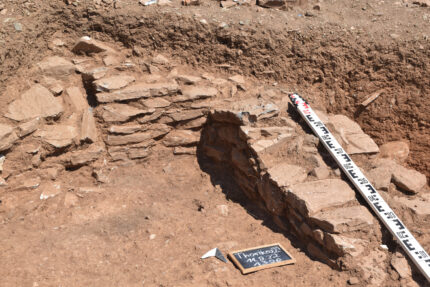 Archaeologists have discovered the remains of the earliest Iron Age house in Attica at the archaeological site of Thorikos 40 miles south of Athens. The structure first emerged in a 2019 excavation that uncovered the corner of a wall. Archaeologists first thought it was the corner of a tomb, but a wider excavation found no burial, but rather a building, likely a dwelling, from the 10th or 9th century B.C.
Archaeologists have discovered the remains of the earliest Iron Age house in Attica at the archaeological site of Thorikos 40 miles south of Athens. The structure first emerged in a 2019 excavation that uncovered the corner of a wall. Archaeologists first thought it was the corner of a tomb, but a wider excavation found no burial, but rather a building, likely a dwelling, from the 10th or 9th century B.C.
Over the past year, the scientists continued to research the extent of the building and identified five to six rooms. In the largest room there were still numerous pebbles in association, which indicate a paved courtyard. An analysis of inorganic and organic features of the rock confirmed a use from about 950 to 825 BC.
“Existing grinding stones for grain indicate a function as a residential building. The differentiated structure of the residential building speaks for either a complex society or an already developed social hierarchy,” says [Prof. Dr. Johannes Bergemann, Director of the Archaeological Institute at the University of Göttingen]. “Scientific analyzes will show whether there was animal breeding here and whether the silver ore typical of the area was mined at this time.”
Inhabited since the 4th millennium B.C., Thorikos was an early center of mining starting from the Neolithic era, first just lead in the 3rd millennium B.C. and then silver from 1500 B.C. Mycenaean underground beehive tombs from that era have been found at the site, and there is material evidence of Mycenaean mining operations at Thorikos dating to the 12th century B.C.
 Thorikos became part of the polis of Athens along with the rest of Attica in around 900 B.C., so the newly-discovered structured dates to the early years of the Athenian synoikismos, the process of combining many small polities into one powerful city-state.
Thorikos became part of the polis of Athens along with the rest of Attica in around 900 B.C., so the newly-discovered structured dates to the early years of the Athenian synoikismos, the process of combining many small polities into one powerful city-state.
With funding now secured from the Gerda Henkel Foundation, the University of Göttingen team in cooperation with the University of Ghent will be able to complete the excavation over the next two years to unearth the full extent of the building. Discoveries will then be studied and analyzed.
Mycenae is about 70 miles away from Athens, and complex stone buildings, tombs as well as “palaces”, were already in the Bronze Age indeed not unusual. Even if the sources are scarce, already Mycenae might have combined small polities into a powerful city-state. In Thorikos, the Mycenaean underground beehive tombs are probably there for a reason.
A truly spectacular beehive tomb is the Late Helladic “Treasury of Atreus” from around 1300BC at Mycenae itself, The largest dome until the Roman period. However, as far as Thorikos is concerned, the Belgian site ‘thorikos.be’ gives a good impression (do mind the drop-down menues in the dim headlines).
The “Mines of Laurion” (Μεταλλεία Λαυρίου) are ancient mines located in southern Attica between Thorikos and Cape Sounion, of which the letter I have visited ages ago. According to Xenophon in the 4th century BC: “[They] have for a very long time been in active operation; no one will venture to fix the date at which they began to be worked.” 😀